The World’s Most Famous Filing Cabinet
After Daniel Ellsberg leaked the Pentagon Papers, the notorious Plumbers broke into his psychiatrist’s office, looking for a way to discredit him
/https://tf-cmsv2-smithsonianmag-media.s3.amazonaws.com/filer/National-Treasure-file-cabinet-631.jpg)
Editor's Note, June 16, 2023: Daniel Ellsberg, the military analyst who leaked the Pentagon Papers in 1971, died of pancreatic cancer today at age 92. Below, read our 2012 article about a filing cabinet that once stood in the office of Ellsberg's psychoanalyst, Lewis Fielding.
Recently, I met with Daniel Ellsberg, now 81, at his house in the hills above Berkeley, California, to get the ultimate insider’s inside account of exposing deception by successive administrations about Vietnam, from the man who is arguably the nation’s most important whistleblower. In particular, I was inquiring about a battered but otherwise seemingly ordinary four-drawer file cabinet, which sits today at the Smithsonian National Museum of American History (NMAH).
The cabinet once stood in the Los Angeles office of Lewis Fielding, Ellsberg’s psychoanalyst. On September 3, 1971, three men led by former CIA agent E. Howard Hunt broke into the office and crowbarred open the drawers. The White House “plumbers” (so named because they were formed to plug leaks, or create them) were after Ellsberg’s file, hoping to find information to be used against him.
In his book-lined living room, Ellsberg reprised the story of how he became, as Henry Kissinger once put it, “the most dangerous man in America.” During the mid-1960s, Ellsberg, a former Marine Corps officer with a PhD in economics from Harvard, was in Vietnam, working for the U.S. State Department, getting a first-hand look at the war. He saw villages that had been burned because Viet Cong had slept there for a night. He returned to the U.S. in 1967, convinced that the military strategy was doomed to fail and increasingly disenchanted with the war.
Once back home, Ellsberg worked as a military analyst at the Rand Corporation, a consulting firm based in Santa Monica. He had access to a 7,000-page Pentagon report on the war’s history and progress (or lack thereof), kept in a safe in his office. Only he and Harry Rowen, the head of Rand, were authorized to read it. What would come to be known as the Pentagon Papers was so restricted that it wasn’t included on Rand’s list of classified documents. “When routine inventories of the contents of safes were done,” he recalls, “I had to take all 47 volumes to Rowen’s office in a grocery cart.”
Distressed by what the report revealed, in 1969 Ellsberg began taking pages out of the office at night and photocopying them at an advertising agency run by a friend. Helped by Rand colleague Anthony Russo, he continued into 1970, then gave copies to certain members of Congress and to New York Times reporter Neil Sheehan. Despite agreeing to keep the report under wraps, Sheehan and editor Gerald Gold began excerpting the report in the newspaper on June 13, 1971. The front-page revelations of continued deceptions gave powerful impetus to the anti-war movement and infuriated President Richard Nixon. Later that year, Ellsberg and Russo were charged under the Espionage Act of 1917.
Their trial began early in 1972. Ellsberg faced a possible sentence of 115 years. “I was the first person ever indicted for a leak of classified information,” he said. “I was prepared to go to prison. The creation of the plumbers, however, was never about the Pentagon Papers. Nixon considered all that history, about the Kennedy and Johnson years. But I had worked for Henry Kissinger in 1969 at the National Security Council, so I knew about Nixon’s big plan for expanding the war, including use of tactical nuclear weapons. Nixon didn’t know how much I knew, but he feared the worst.” On an Oval Office tape, from July 27, 1971, Kissinger, speaking to Nixon, referred to Ellsberg as “that son of a bitch. ... I would expect—I know him well. ... I am sure he has some more information.”
A short time later, Hunt drafted a proposal to “neutralize Ellsberg,” leading to the Fielding operation. The break-in was revealed only after a nine-month recess in the trial, calculated by the White House to keep Ellsberg off the witness stand and out of the news until after the presidential election.“The first time I found out about the break-in,” Ellsberg said, “was when government prosecutors revealed it to the judge, and he told my lawyers. Nixon had wanted that information withheld, but he’d been warned that this could make him criminally liable. The judge cited government misconduct and dismissed all charges.”
News reports at the time claimed that the burglars hadn’t located Ellsberg’s file. “The plumbers did find my file,” Ellsberg told me. “In it was a paper I had written for the American Political Science Association called ‘Quagmire Myth and the Stalemate Machine.’ I alluded to classified information I’d seen, which obviously meant the Pentagon report.”
At a neighborhood restaurant, where we drove in Ellsberg’s slightly beat-up red Miata, he speculated on the ironies of history. “Had my lawyers and I known about the break-in from the beginning, [John] Ehrlichman would have had to shut down the illegal plumbers operation, and the Watergate break-in of June 1972 might never have taken place.”
NMAH curator Harry Rubenstein concurs. “Would the plumbers group have been formed if they hadn’t wanted Ellsberg’s file? Probably not.” This humble filing cabinet, he says, “was the beginning of the end of the Nixon presidency.”
/https://tf-cmsv2-smithsonianmag-media.s3.amazonaws.com/accounts/headshot/Owen-Edwards-240.jpg)

/https://tf-cmsv2-smithsonianmag-media.s3.amazonaws.com/accounts/headshot/Owen-Edwards-240.jpg)